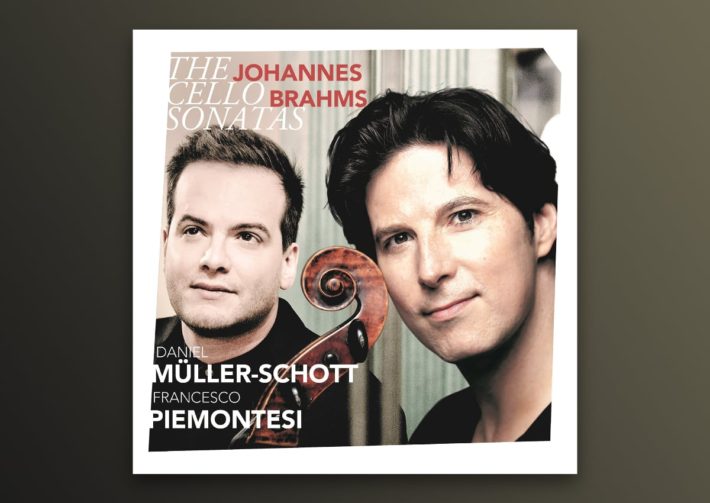Brahms himself, according to certain testimonies, once noted of his Cello Sonata No. 1 that the piano “should be a partner – often a leading, often a watchful and considerate partner – but it should under no circumstances assume a purely accompanying role.” The performance certainly upholds these words, and what emerges is a skillful collaboration. This is despite, and not because of, the very close attention the recording engineers are giving to the cello over the piano in the sound picture.
Brahms wrote his first Cello Sonata (1862-1865) as a sort of compositional homage to his three predecessors: Beethoven, Schubert, and Bach. Müller-Schott and Piemontesi pay meticulous attention to these small homages in a vibrant interpretation. The duo engage in an active dialogue throughout, each knowing when and how to step back smoothly from a soloistic moment into a supporting role. Even in these accompanimental moments, both players pay close attention to elements of phrasing that supports the synchronicity.
In the first movement, the cellist has a tone that is full-bodied yet mellow and evocative. The opening, for instance, presents the cello in a meaningful monologue, but this would not be possible without the pianist’s delicate and thoughtful accompaniment. The second movement is reminiscent of a Schubert dance – gracefully restrained yet lyrical. In retrospect, it is this restraint that becomes an effective means in setting up the Allegro (track 3). A reference to Contrapunctus 13 of Bach’s Art of Fugue in its rhythmic and melodic textures, the opening phrase is in fact a brief canon. The performers exudes a fierce energy here and throughout the movement.
Related Classical Music Reviews
- Review: Clyne, Elgar – Cello Concertos – Inbal Segev, LPO, Alsop
- Review: Franck and Chopin – Cello Sonatas – Gautier Capuçon, Yuja Wang
- Review: “Quasi Morendo” – Brahms Clarinet Quintet et al. – Reto Bieri, Clarinet, Meta4 Quartet
Almost two decades later, Brahms finished his F major cello sonata (1886). One can hear the elements of a matured composer, an increased musical complexity and reference to the symphonic genre. The opening movement (track 7) is a good example: here, the piano accompaniment represents an orchestra with its character in its opening tremolos and arpeggiated figures. The pianist highlights this aspect well but still maintains an awareness for the cello’s presence.
The Adagio affettuoso (track 8) is, to me, the pinnacle of the work. In relation to the rest of the movements, F# major is an innovative choice for the composer, but not without reason. This naturally bright tonality, along with the melodic lines, truly embodies his romanticism. I found this performance impressive for its sensitivity. Almost all of the cello’s lines (save for the pizzicatos) are written in its upper range, and so the instrument has a very different presence. Müller-Schott’s sound-quality shines here, enabling us to imagine this movement both as a tender lullaby and as a passionate ballad.
The Op. 77 G major violin sonata (1878-79) has a connection to Brahms’ vocal works, namely Regenlied and Nachtklang, the Op. 59 lieder. In many ways, the cello in the first movement (track 4) is just like a singer weaving through with a meandering line. Here we have the usual, unnamed “Simrock” published transcription for cello and piano in D, though the booklet says Müller-Schott made his own changes to the cello part. What’s interesting is that this transcription for a larger string instrument gives the work added warmth and resonance, elements which Müller-Schott bring to the forefront.
The final Allegro molto moderato (track 6) uses motivic elements from the previous movements, thus giving the work its cyclic form. While the movement is not as dramatic or virtuosic in the way the finale of E minor sonata, it is nonetheless exciting thanks to the duo’s expression of underlying mystery and restlessness. Piemontesi in particular has a clarity of sound in the notes that scurry forward, and the cellist makes good use of emphasis on unexpected melodic dissonances (2:45-3:15). This tension dissipates upon the arrival of the beautifully played D major section.
A worthwhile listening, then. The only reservation, as mentioned before, is the close and slightly airless recording. But the quality of the music-making is such that the ear soon adapts, and fans of Muller-Schott will have an opportunity to follow his cello technique closely.

Brahms – Cello Sonatas, Violin Sonata No. 2 (trans. for cello and piano)
Daniel Müller-Schott – Cello
Francesco Piemontesi – Piano
Orfeo, CD C979201
Recommended Comparisons
Read more classical music reviews or visit The Classic Review Amazon store
Follow Us and Comment:
[wd_hustle id=”HustlePostEmbed” type=”embedded”]











